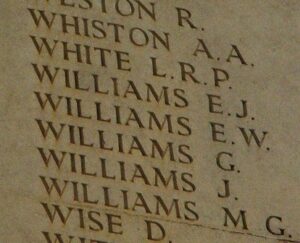Jeffreyston lies on the B4586 road, about six miles northwest of Tenby, north of the main A470 road between Pembroke and Carmarthen. As well as Jeffreyston itself, the community includes the settlements of Broadmoor, Cresselly, Loveston and Yerbeston. The area used to be mined for coal, which was shipped from Cresswell Quay. The Parish Church is dedicated to Saint Jeffrey and Saint Oswald, and contains memorials to the men of the Parish who fell during both World Wars. Many thanks to Mike Berrell for the photographs of the memorials.
The Great War, 1914-1918
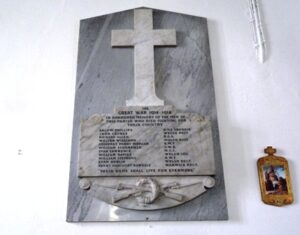
Richard Allen, Gunner, 43600, Royal Garrison Artillery. Richard was born in 1886, the son of Ben and Sarah Allen, of Jeffreyston. Prior to the war he resided at Liverpool, with his sisters Eliza and Martha, and Eliza’s husband William, and worked there as a taxi cab driver. Richard enlisted at Liverpool into the Royal Garrison Artillery, and was posted to their 16th Heavy Battery. The battery moved to the Western Front on 10 July 1915 with 21 Heavy Artillery Brigade, and took up positions north of Arras. Richard was wounded at Arras, and died of his wounds on 28 April 1916, aged 31. He is buried in Aubigny Communal Cemetery Extension, France.
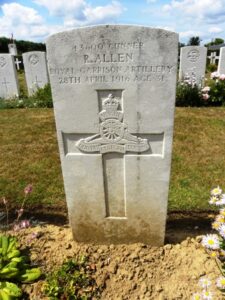
William Davies, Private, 2916, Welsh Guards. William was born in 1890, the son of William and Esther Davies, of South Lodge, Cresselly. He was a teacher prior to the war, and enlisted at Pembroke into the South Wales Borderers. After the formation of the Welsh Guards in February 1915, William transferred into the 1st Battalion, Welsh Guards, which was in France attached to 3rd Guards Brigade, Guards Division, and joined the battalion in France in 1916. In July 1916 the Division moved to the Somme, where they fought at the Battle of Flers-Courcelette, and then at the Battle of Morval, capturing Lesboeufs Village. They remained here for the winter, and in March 1917 took part in the advance caused by the German Retreat to the Hindenburg Line. Later that year they moved north to Ypres, where they fought at the Battle of Pilkem Ridge. William was killed during the attack near Houthulst Forest on 13 October 1917, which was part of the First Battle of Passchendaele. He was 27 years old, and is commemorated on the Tyne Cot Memorial, Belgium.
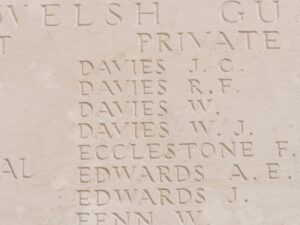
John George, Private, 11782, Welsh Regiment. John was born in 1889, the son of William and Margaret George, of 7, Jeffreyston Row. Prior to the war he worked as a Collier, and resided at 15, Margaret Street, Treherbert. John enlisted on 17 August 1914 at Pentre into the Welsh Regiment, but on 8 May 1915 was discharged on medical grounds. He died at home later that year, aged 26. Nothing further is yet known of John, as he is not commemorated by the CWGC.
Henry Harcourt Howells, Private, 32543, Royal Warwickshire Regiment. Henry was born at Marros in 1892, the son of Peter and Rachel Howells, of Talvan, Marros. Prior to the war the family were residing at Rhymney, and Henry enlisted at Cardiff into the Welsh Horse Yeomanry. After the Welsh Horse embarked for Gallipoli, Henry was transferred to the Middlesex Regiment, then to the 17th Lancers, before landing in France, where he joined the 14th Battalion, Royal Warwickshire Regiment. The battalion was attached to 13 Brigade, 5th Division, and Henry probably joined them on the Somme. On 1 July 1916 the Battle of the Somme opened, and the Division fought at High Wood, Guillemont, Flers-Courcelette, Morval and Le Transloy. On 5 October, after suffering heavy casualties, the Division moved to Festubert, where they remained until March 1917, until taking part in the Battle of Arras. On 7 September 1917 the Division was pulled out of the line, and moved north to Ypres, and on 26 September 1917 fought at the Battle of Polygon Wood, and in the ensuing Battle of Broodseinde. Henry was killed in action at Broodseinde on 5 October 1917. He was 25 years old, and is commemorated on the Tyne Cot Memorial, Belgium.

Harold Godwin Hurlow, Corporal, 45069, Welsh Regiment. Harold was the son of Benjamin and Sarah Hurlow, of Broadmoor, near Begelly. He worked as a miner prior to enlisting at Cardiff into the 2nd Battalion, Welsh Regiment. He was posted to France in the summer of 1916 to join the battalion, which was by then on the Somme attached to 3 Brigade, 1st Division. He would have taken part in the divisions actions on the Somme, during their epic fight at Munster Alley during the Battle of Pozieres and in the further fighting towards Morval. The division followed the German retreat to the Hindenburg Line in early 1917, and then moved to the Flanders Coast during the summer of 1917. While readying for the hoped breakthrough at Ypres, which did not occur, the coastal operation was cancelled and the 1st Division was moved to Ypres, taking part in the Second Battle of Passchendaele. The division wintered in Flanders and was near Estaires when the German’s launched their Lys Offensive and got caught up in heavy fighting before being moved to the Arras sector and from there took part in the great offensive, which was launched on 21 August 1918. Fighting at the Battle of Drocourt-Quéant, and at the Battle of Épehy the division took part in the advance towards the St. Quentin Canal. Harold was killed in action during the assault on the fortified village of Fresnoy le Petit on 22 September 1918, aged 35. He is buried in Marteville Communal Cemetery, Attilly, France. Harold is commemorated on his parents grave at Cold Inn, but does not appear to be commemorated on any local war memorial as far as I have seen.
Evan Lawrence, Private, 85947, Machine Gun Corps. Evan was born in 1896, the son of William and Ellen Lawrence, of Langdon Bridge, Begelly. He enlisted at Pembroke on 10 December 1915 into the Welsh Regiment. Evan landed in France on 27 August 1917, and joined the 56th Company, Machine Gun Corps, which was attached to 56 Brigade, 19th (Western) Division. The Division was at Ypres, after having taken part in the Battle of Messines, and was about to launch an attack near the Menin Road. Evan was killed in action during his first major action, on 20 September 1917. He was 21 years old, and is buried at Oxford Road Cemetery, Belgium.
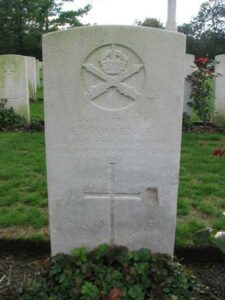
Geoffrey Penney Morgan, Lieutenant, Royal Welsh Fusiliers. Geoffrey was born at Mold, Flintshire in 1895, the son of William and Elizabeth Morgan. William had been the Congregational Minister at Jeffreyston for several years, where he married Elizabeth, who was from the village, and two of Geoffrey’s elder siblings had been born there. Geoffrey originally enlisted into the Royal Welsh Fusiliers as a Private and landed in France on 3 December 1915 with the 38th (Welsh) Division. He served with the Division at Fleurbaix, and just prior to its move to the Somme in June 1916, was commissioned into the 1st Battalion, Royal Welsh Fusiliers. The battalion was attached to 22 Brigade, 7th Division, and was the battalion of the war poets Siegfried Sassoon and Robert Graves. Geoffrey was posted to A Company, 1st RWF, which was on the Somme at Fricourt. Geoffrey then fought with the battalion during its famous attack on Fricourt and Mametz Village on 1 July 1916. The battalion remained in the area over the coming days, while the 38th Division made its attacks on Mametz Wood, and after the capture of the Wood, the 7th Division moved past it towards Bazentin Wood, and on 14 July 1916 attacked Bazentin-le-Petit. Geoffrey was mortally wounded during the attack that day and died soon after. He was 21 years old, and is commemorated on the Thiepval Memorial, France.
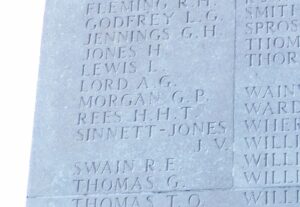
Stephen Arla Phillips, Armourer, 340270, Royal Navy. Stephen was born on 5 October 1870, the son of Thomas Phillips and Sarah Phillips (nee Prout), of Cresswell Quay. In 1897 he married Hannah Palmer, of Black Tar, Llangwm, where they raised four children. Stephen served in the Royal Navy as a regular, and at the outbreak of war was an Armourer aboard the armoured cruiser HMS Aboukir. She had been launched in 1900, and at the outbreak of war was sent along with her sister ships Bacchante, Euryalus, Hogue and Cressy to patrol the North Sea. At around 06.00 on 22 September 1914 the three cruisers were spotted by the German submarine U-9. Aboukir was hit by the first torpedo and broke in half, sinking within 20 minutes with the loss of 527 men. The captains of the Cressy and Hogue thought the Aboukir had struck a mine and came forward to assist her, and were both sunk in turn by the U-9. The entire battle had lasted less than two hours, and cost the British three warships, 62 officers and 1,397 ratings. Amongst the dead was Stephen. He was 45 years old, and is commemorated on the Chatham Naval Memorial, Kent.
Evan Roblin, Private, 25846, Welsh Regiment. Evan was the son of James and Phoebe Roblin of Callings Ford, Jeffreyston. He worked in the South Wales coal mines for several years prior to the war, and enlisted at Neath into the 18th Battalion, Welsh Regiment, which was attached to 119 Brigade, 40th (Bantam) Division. The Division moved to France during June 1916, and moved to the front near Loos. Late in 1916 they moved south to the Somme, and fought at the Battle of the Ancre, and remained in the area over the winter. In March 1917 the Germans withdrew to their shortened line, called the Hindenburg Line, and the 40th Division was one of the Divisions that followed the withdrawal. Later in the year they took part in the Battle of Cambrai, playing an important role in the attack on Bourlon Wood. They remained in the area over the coming months, but were caught here by the German Spring Offensive of 21 March 1918, and suffered heavy casualties in the ensuing days. The battered Division was sent north to Flanders to rest and rebuild, but in April the Germans launched an offensive in Flanders, and the 40th Division was caught up in the thick of it again. Following losses in the defence of Hazebrouck, the Division was reduced to a training cadre, before being rebuilt, and was ready for front-line action again by 18 July 1918, when they took part in the Advance in Flanders. Evan must have been taken prisoner by the Germans during the spring of 1918, as he died in captivity on 29 July 1918, aged 43. Evan is buried at Tournai Communal Cemetery, Allied Extension, Belgium.
William Scourfield, Private, 29530, South Wales Borderers. William was born in 1898, the son of John Scourfield and Catherine Scourfield (nee Batson), of Cresswell Quay, Cresselly. William enlisted at Pembroke into the 3rd Battalion, South Wales Borderers, which was a reserve battalion. William was still on Home Service when he took ill, and died at the Military Hospital at Liverpool of sickness on 26 February 1917 aged just 18. He was brought home to be buried at Pisgah Baptist Chapelyard.
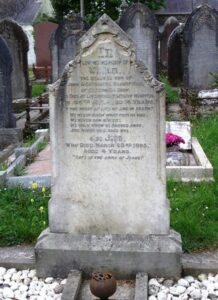
William Stephens, Private, 60122, Royal Welsh Fusiliers. William was the son of James and Elizabeth Stephens, of Whitlow Hill, Landshipping. He married Mary Arthur in 1905, and the couple resided at 1, Pisgah. Cresselly. William enlisted into the Army Service Corps, but was later transferred to the 15th Battalion, Royal Welsh Fusiliers, which was attached to 113 Brigade, 38th (Welsh) Division. William probably joined the battalion after its efforts in the capture of Mametz Wood in July 1916, and its move to the Canal Bank at Boesinghe. The Division held this position for several months, prior to moving into position on 20 July 1917 in readiness for the forthcoming assault on the Pilckem Ridge. On 27 July 1915, A Company, 15th RWF was tasked with a reconnaissance on the German lines opposite, and moved stealthily across No Man’s Land to carry out its task. The German’s had spotted the company, and poured machine-gun fire into the men, wiping out the whole company. William was among the men killed that day. He was 36 years old, and is commemorated on the Ypres (Menin Gate) Memorial, Belgium.
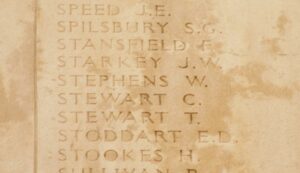
Walter Williams, Private, 16395, Welsh Regiment. Walter was born in 1896, the son of Evan and Martha Williams, of Cresselly. He enlisted at Treherbert into the 10th Battalion (1st Rhondda), Welsh Regiment, which trained at Rhyl, before moving to Winchester in the summer of 1915 attached to 114 Brigade, 38th (Welsh) Division. On 2 December 1915 the battalion moved to France, and the entire Division moved to the Fleurbaix sector, where it was initiated into trench warfare. During June 1916 the Division marched south to the Somme, and on 7 July 1916 attacked Mametz Wood. The initial attack failed, and it was three days later, on 10 July, that a fresh attack was mounted. Walter was reported as missing believed killed in action in Mametz Wood on 12 July 1916. He was 19 years old, and is commemorated on the Thiepval Memorial, France.
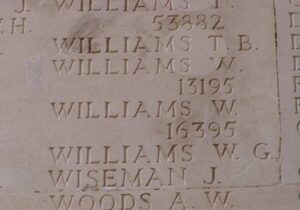
World War Two, 1939-1945
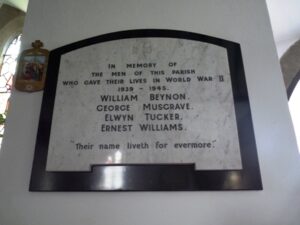
William Thomas Beynon, Chief Stoker, P/KX 75197, Royal Navy. William was born on 8 July 1906, the son of Lewis and Sarah Beynon, of Jeffreyston. He married at the outbreak of war, and his wife, Beatrice Elizabeth Beynon, resided at New Tredegar, Monmouthshire. William served with the Royal Navy aboard the sloop HMS Egret, which served with the 1st Support Group. On 27 August 1943 was on anti-submarine patrol in the Bay of Biscay when the group was attacked by a squadron of eighteen Dornier Do 217’s, carrying Henschel glider bombs, an early type of guided missile. Egret infamously became the first ship ever to be sunk by a guided missile, when she was struck by one of these Henschel glider bombs that day, and sank with the loss of 194 of her crew. William was amongst the dead. He was 37 years old, and is commemorated on the Portsmouth Naval Memorial, Hampshire.
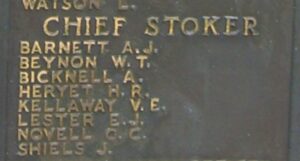
George Stanley Musgrave, Lance Serjeant, 2692600, Scots Guards. George was born in 1910, the son of George and Emily Musgrave, of Hayes, Middlesex. He married Phyllis Winifred Phillips, of Jeffreyston in 1933. George served with the 2nd Battalion, Scots Guards. The battalion was attached to 22nd Guards Brigade, and fought in the North African campaign from 1942, and at El Alamein in 1942, before taking part in the invasion of Italy in September 1943, landing at Salerno. The Guards took part in the advance to Monte Cassino, and in the terrible fighting for the abbey. George was killed in Italy on 23 January 1944. He was 34 years old, and is buried at Minturno War Cemetery, Italy.
Walter Elwyn Tucker, Gunner, 1076759, Royal Artillery. Walter was the son of Melbourne Charles and Selina Maude Tucker of Jeffreyston. Walter was serving with the 112 (The West Somerset Yeomanry) Field Regiment, Royal Artillery, and was stationed in Middlesex, when he met and married Catherine Adelaide Hazell, of Palmers Green, Middlesex, in 1943. Walter landed at Normandy with the regiment on 24 June 1944. The regiment was attached to the 43rd (Wessex) Division, and took part in the break-out from the Normandy beachhead. Walter was killed during heavy fighting against the 9th SS Panzer Division at Hill 112 on 22 July 1944. He was 29 years old, and is buried at St. Manvieu War Cemetery, Cheux, France.
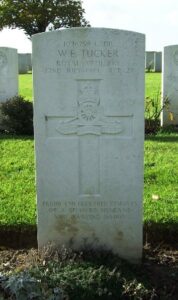
Ivor James Vaughan, Engineman, LT/X 603ES, Royal Naval Reserve (Patrol Service). Ivor was the son of Thomas James Vaughan and Rhoda Vaughan, of Jeffreston. He served with the Royal Naval Reserve prior to the war, and after being called up, joined the Royal Naval Patrol Service, and served aboard H.M. Trawler Concordia, which was an anti-submarine vessel. Ivor became ill during his service at sea, and died on 19 November 1942, aged 32. He is buried in Cold Inn (Ebenezer) Baptist Chapelyard. Ivor does not seem to be commemorated locally.
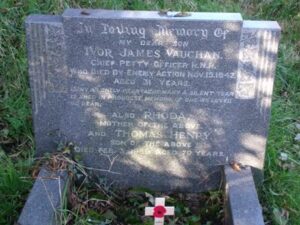
Ernest Walter Williams, Private, 4197586, The King’s Regiment (Liverpool). Ernest was born in 1915, and was the nephew of E. A. Scourfield of The Court, Cresselly. He enlisted into the Royal Welch Fusiliers, but was later transferred into the 13th Battalion, King’s Regiment, and was posted to Burma. The battalion took part in Orde Wingate’s Chindit expedition into Burma in late 1942. Ernest was reported missing in April 1943, and it wasn’t until April 1946 that his family received confirmation that he had been killed, the official date being given as 11 April 1943. Ernest was 25 years old, and is commemorated on the Rangoon Memorial, Myanmar.
